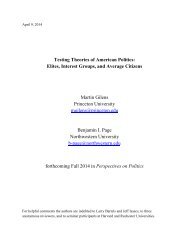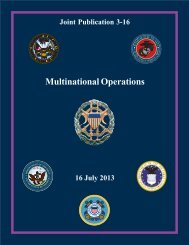ABUSE OF STRUCTURED FINANCIAL PRODUCTS- Misusing Basket Options to Avoid Taxes and Leverage Limits MAJORITY AND MINORITY STAFF REPORT
ABUSE OF STRUCTURED FINANCIAL PRODUCTS- Misusing Basket Options to Avoid Taxes and Leverage Limits MAJORITY AND MINORITY STAFF REPORT
ABUSE OF STRUCTURED FINANCIAL PRODUCTS- Misusing Basket Options to Avoid Taxes and Leverage Limits MAJORITY AND MINORITY STAFF REPORT
You also want an ePaper? Increase the reach of your titles
YUMPU automatically turns print PDFs into web optimized ePapers that Google loves.
80<br />
securities as collateral for the loan. One analyst summarized the policy reasons for imposing the<br />
margin rules as follows:<br />
“(1) <strong>to</strong> ‘prevent[ ] the excessive use of credit for the purchase or carrying of securities’;<br />
(2) ‘<strong>to</strong> protect the margin purchaser by making it impossible for him <strong>to</strong> buy securities on<br />
<strong>to</strong>o thin a margin’; <strong>and</strong> (3) <strong>to</strong> ‘prevent undue market fluctuations <strong>and</strong> help stabilize the<br />
economy generally ….’ In short, margin rules were created <strong>to</strong> protect individual<br />
inves<strong>to</strong>rs, the market, <strong>and</strong> the economy as a whole.” 426<br />
A number of representatives indicated that Deutsche Bank, Barclays, RenTec, <strong>and</strong><br />
George Weiss viewed achieving leverage beyond the limits of Regulation T as a major business<br />
objective for entering in<strong>to</strong> the basket options. 427 In a 2012 letter <strong>to</strong> the IRS, for example, RenTec<br />
described its past use of leverage <strong>and</strong> how the basket options provided more leverage than it had<br />
achieved in any other setting:<br />
“<strong>Leverage</strong> … is restricted by the U.S. Federal Reserve’s Regulations T, U, <strong>and</strong> X,<br />
commonly referred <strong>to</strong> as the ‘margin rules.’ The margin rules limit the extent <strong>to</strong> which<br />
brokerage cus<strong>to</strong>mers can borrow against the s<strong>to</strong>ck positions that they own. …<br />
A brokerage account in which an inves<strong>to</strong>r can trade s<strong>to</strong>cks utilizing money borrowed<br />
from the broker is referred <strong>to</strong> as a ‘margin account.’ A margin account can be opened in<br />
connection with a prime brokerage arrangement. Under the relevant Federal Reserve<br />
Regulations, if a Renaissance fund were <strong>to</strong> seek <strong>to</strong> obtain leverage by trading long <strong>and</strong><br />
short positions in such a prime brokerage margin account held at a U.S. broker-dealer, it<br />
would be able <strong>to</strong> achieve leverage of no more than 2:1. That is, in order <strong>to</strong> hold $100 of<br />
long positions <strong>and</strong> $100 of short positions, the Renaissance fund would have <strong>to</strong> have<br />
invested $100 in the account.<br />
To achieve greater leverage, Renaissance made use of a ‘joint back office’ or ‘JBO’<br />
arrangement. This involved qualifying one of Renaissance’s investment funds as a<br />
registered broker-dealer in its own right, trading for its own account. As a result, the<br />
fund was exempt from the margin rules <strong>and</strong> was instead subject <strong>to</strong> the SEC ‘net capital’<br />
rules …. This amounted <strong>to</strong> a leverage ratio limit of approximately 7.6:1 428 (i.e., with<br />
$100 of equity the fund could hold approximately $335 of long positions <strong>and</strong> $335 of<br />
short positions.) Renaissance’s fund that had a JBO arrangement during 2005 <strong>and</strong> 2006<br />
had an average leverage ratio of 4.6:1 during those years, with a peak leverage ratio of<br />
6.4:1.<br />
In the late 1990s, Renaissance began discussions with DB [Deutsche Bank] regarding the<br />
possibility of purchasing options from DB that would give Renaissance funds highly<br />
leveraged exposure …. DB was initially prepared <strong>to</strong> make leverage of up <strong>to</strong> 16:1<br />
426 “<strong>Leverage</strong>d ETFs: The Trojan Horse has Passed the Margin-Rule Gates,” 34 Seattle U.L. Rev. 299, 310, William<br />
M. Humphries (Fall 2010) (omitting citations).<br />
427 Subcommittee interviews of Frederick Doucette, GWA (5/23/2014), Peter Brown, RenTec (6/3/2014), Satish<br />
Ramakrishna, Deutsche Bank (5/16/2014) <strong>and</strong> Martin Malloy, Barclays (5/1/2014).<br />
428 RenTec informed the Subcommittee that in its original submission <strong>to</strong> the IRS, it transposed the numbers<br />
describing the permissible leverage of a JBO arrangement <strong>and</strong> incorrectly listed it as 6.7:1, but is providing<br />
corrected information <strong>to</strong> the IRS.







